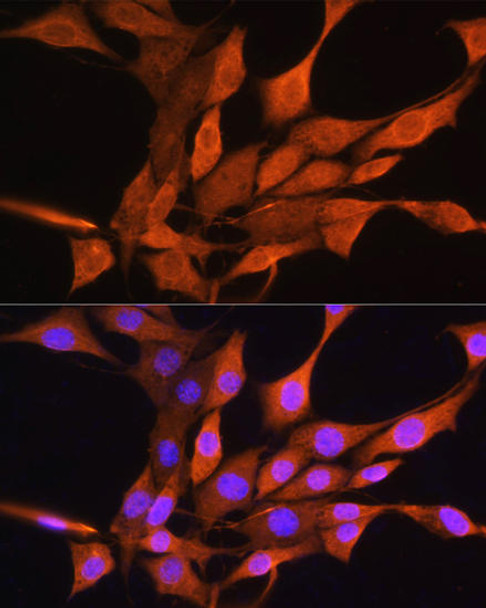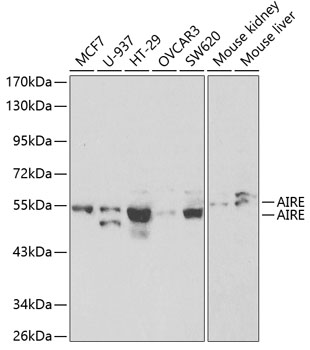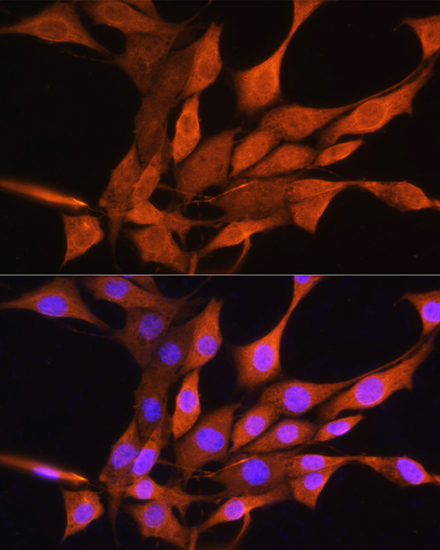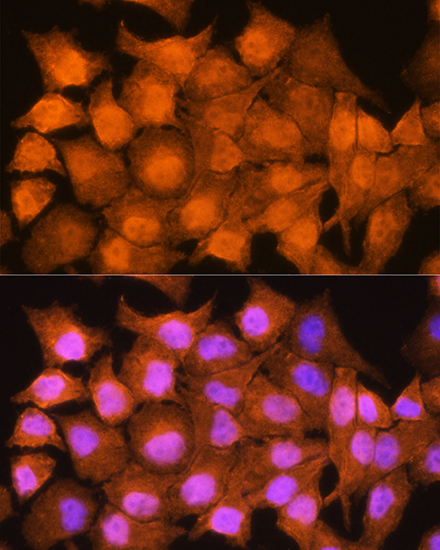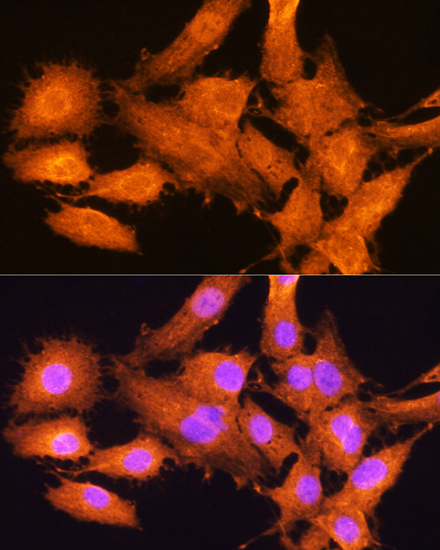Anti-AIRE Antibody (CAB1767)
- SKU:
- CAB1767
- Product type:
- Antibody
- Reactivity:
- Human
- Reactivity:
- Mouse
- Reactivity:
- Rat
- Host Species:
- Rabbit
- Isotype:
- IgG
- Antibody Type:
- Polyclonal Antibody
- Research Area:
- Epigenetics and Nuclear Signaling
Frequently bought together:
Description
| 抗体名: | Anti-AIRE Antibody |
| 抗体コード: | CAB1767 |
| 抗体サイズ: | 20uL, 50uL, 100uL |
| 申し込み: | WB IF |
| 反応性: | Human, Mouse, Rat |
| 宿主種: | Rabbit |
| 免疫原: | A synthetic peptide corresponding to a sequence within amino acids 30-130 of human AIRE (NP_000374.1). |
| 申し込み: | WB IF |
| 推奨希釈: | WB 1:500 - 1:2000 IF 1:50 - 1:200 |
| 反応性: | Human, Mouse, Rat |
| ポジティブサンプル: | MCF7, U-937, HT-29, OVCAR3, SW620, Mouse kidney, Mouse liver |
| 免疫原: | A synthetic peptide corresponding to a sequence within amino acids 30-130 of human AIRE (NP_000374.1). |
| 精製方法: | Affinity purification |
| ストレージバッファ: | Store at -20'C. Avoid freeze / thaw cycles. Buffer: PBS with 0.02% sodium azide, 50% glycerol, pH7.3. |
| アイソタイプ: | IgG |
| 順序: | HALA DHDV VPED KFQE TLHL KEKE GCPQ AFHA LLSW LLTQ DSTA ILDF WRVL FKDY NLER YGRL QPIL DSFP KDVD LSQP RKGR KPPA VPKA LVPP PRLP T |
| 遺伝子ID: | 326 |
| Uniprot: | O43918 |
| セルラーロケーション: | Cytoplasm, Nucleus |
| 計算された分子量: | 25kDa/35kDa/36kDa/57kDa |
| 観察された分子量: | 55kDa |
| 同義語: | AIRE, AIRE1, APECED, APS1, APSI, PGA1 |
| バックグラウンド: | This gene encodes a transcriptional regulator that forms nuclear bodies and interacts with the transcriptional coactivator CREB binding protein. The encoded protein plays an important role in immunity by regulating the expression of autoantigens and negative selection of autoreactive T-cells in the thymus. Mutations in this gene cause the rare autosomal-recessive systemic autoimmune disease termed autoimmune polyendocrinopathy with candidiasis and ectodermal dystrophy (APECED). |
| UniProt Protein Function: | AIRE: Transcriptional regulator that binds to DNA as a dimer or as a tetramer, but not as a monomer. Binds to G-doublets in an A/T-rich environment; the preferred motif is a tandem repeat of 5'-. ATTGGTTA-3' combined with a 5'-TTATTA-3' box. Binds to nucleosomes. Binds to chromatin and interacts selectively with histone H3 that is not methylated at 'Lys-4', not phosphorylated at 'Thr-3' and not methylated at 'Arg-2'. Functions as a sensor of histone H3 modifications that are important for the epigenetic regulation of gene expression. Functions as a transcriptional activator and promotes the expression of otherwise tissue-specific self-antigens in the thymus, which is important for self tolerance and the avoidance of autoimmune reactions. Defects in AIRE are a cause of autoimmune poly- endocrinopathy candidiasis ectodermal dystrophy (APS1). An autosomal recessive disease characterized by the combination of chronic mucocutaneous candidiasis, hypoparathyroidism and Addison disease. Symptoms of mucocutaneous candidiasis manifest first, followed by hypotension or fatigue occurring as a result of Addison disease. APS1 is associated with other autoimmune disorders including diabetes mellitus, vitiligo, alopecia, hepatitis, pernicious anemia and primary hypothyroidism. Most of the mutations alter the nucleus-cytoplasm distribution of AIRE and disturb its association with nuclear dots and cytoplasmic filaments. Most of the mutations also decrease transactivation of the protein. The HSR domain is responsible for the homomultimerization activity of AIRE. All the missense mutations of the HSR and the SAND domains decrease this activity, but those in other domains do not. The AIRE protein is present in soluble high-molecular-weight complexes. Mutations in the HSR domain and deletion of PHD zinc fingers disturb the formation of these complexes. 4 isoforms of the human protein are produced by alternative splicing. |
| UniProt Protein Details: | Protein type:Transcription factor Chromosomal Location of Human Ortholog: 21q22.3 Molecular Function:chromatin binding; histone binding; protein binding; transcription cofactor activity; zinc ion binding Biological Process: immune response; positive regulation of transcription from RNA polymerase II promoter; positive regulation of transcription, DNA-dependent; regulation of transcription, DNA-dependent Disease: Autoimmune Polyendocrine Syndrome, Type I, With Or Without Reversible Metaphyseal Dysplasia |
| NCBI Summary: | This gene encodes a transcriptional regulator that forms nuclear bodies and interacts with the transcriptional coactivator CREB binding protein. The encoded protein plays an important role in immunity by regulating the expression of autoantigens and negative selection of autoreactive T-cells in the thymus. Mutations in this gene cause the rare autosomal-recessive systemic autoimmune disease termed autoimmune polyendocrinopathy with candidiasis and ectodermal dystrophy (APECED). [provided by RefSeq, Jun 2012] |
| UniProt Code: | O43918 |
| NCBI GenInfo Identifier: | 3334119 |
| NCBI Gene ID: | 326 |
| NCBI Accession: | O43918.1 |
| UniProt Secondary Accession: | O43918,O43922, O43932, O75745, B2RP50, |
| UniProt Related Accession: | O43918 |
| Molecular Weight: | 36,501 Da |
| NCBI Full Name: | Autoimmune regulator |
| NCBI Synonym Full Names: | autoimmune regulator |
| NCBI Official Symbol: | AIRE |
| NCBI Official Synonym Symbols: | APS1; APSI; PGA1; AIRE1; APECED |
| NCBI Protein Information: | autoimmune regulator |
| UniProt Protein Name: | Autoimmune regulator |
| UniProt Synonym Protein Names: | Autoimmune polyendocrinopathy candidiasis ectodermal dystrophy protein; APECED protein |
| Protein Family: | Autoimmune regulator |
| UniProt Gene Name: | AIRE |
| UniProt Entry Name: | AIRE_HUMAN |
View AllClose

